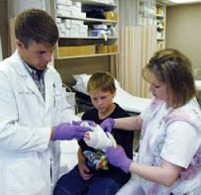|
Orthopedics usually deals with the musculoskeletal system of the human body. The system includes nerves, muscles, joints, ligaments, tendons and bones. Thus, orthopedic primarily deals with all those that form a link between various parts of the body and hold them together for proper coordination and movement.
 Emergencies of orthopedic mainly include the emergencies or sudden disorders that may arise in the bones, muscles or the joints of human body. The disorders are common in women and men alike and may occur at any age. Orthopedic emergencies in children are difficult to treat as compared to those in adults because of the difference of growth pattern. In small children, the bones and muscles are still into the developmental stage and are not as strong as those in the adults. The line of treatment to be adopted during emergencies in the musculoskeletal system of adults is much different from that adopted in the pediatric patients. Also, the time period for recovery of orthopedic injuries is more in pediatrics as compared to the adults if the injury or fracture is complicated. X-rays is the best available method to detect orthopedic injuries. Emergencies of orthopedic mainly include the emergencies or sudden disorders that may arise in the bones, muscles or the joints of human body. The disorders are common in women and men alike and may occur at any age. Orthopedic emergencies in children are difficult to treat as compared to those in adults because of the difference of growth pattern. In small children, the bones and muscles are still into the developmental stage and are not as strong as those in the adults. The line of treatment to be adopted during emergencies in the musculoskeletal system of adults is much different from that adopted in the pediatric patients. Also, the time period for recovery of orthopedic injuries is more in pediatrics as compared to the adults if the injury or fracture is complicated. X-rays is the best available method to detect orthopedic injuries.
Bone Fractures
Most of the orthopedic emergencies deal with bone fractures or muscle sprain. Bone fractures are quite common and may lead to swelling and severe pain near the affected area. Distal radius fracture is the most common form of fracture occurring in children and accounts for almost 20% of the overall cases of pediatric fractures. Slipped capital femoral epiphysis is another common form of orthopedic emergency in children and occurs mostly in the age group of 10-15 years. Boys are more prone to the disorder as compared to girls and the fracture is not as common as distal radius fracture. Radial head subluxation is another important form of orthopedic emergency occurring in pediatrics. It is also known as temper tantrum elbow, nursemaid�s elbow or pulled elbow.
Apart from fractures and bone disorders, other important types of emergencies relating to the orthopedics are the knee joint, dislocations, neurovascular injuries and septic joints. Open fracture is another type of orthopedic emergency in which the fractured area comes in contact with the outer environment due to cracking of skin covering the fracture. The disorder may also lead to osteomyelitis or soft tissue infection. Dislocation of bones or severe muscle stretch is also a form of emergency of orthopedics and must be cured in time to avoid further complications.
Varied forms of treatments are available to treat the emergencies in orthopedics.
- Physiotherapy
- Acupuncture
- Podiatry
- Kinesiology
- Chiropractic Therapy
These are some of the common forms of treatment recommended for emergencies in orthopedics. Treating the disorders in the initial period is very important to avoid pains in the joints. This may also benefit the patient in smooth body movements. Surgery is also recommended in some cases where an abnormal or excess growth of bone is detected.
Orthopedic emergencies can be tackled by proper medication and regular exercise. Most of the orthopedic problems are due to insufficient movement of the body and daily exercise will help in keeping all the body parts active. Orthopedic problems are quite common worldwide and the chances of their occurrence increases with age. It is relatively difficult to heal emergencies in the orthopedics in old-age people as compared to other age groups.
|